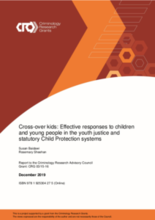Displaying 591 - 600 of 2214
Using Swedish longitudinal register data on 2.167 children with experience of long-term foster care, this study explores the hypothesized mediating role of foster parents’ educational attainment on foster children’s educational outcomes, here conceptualized as having poor school performance at age 15 and only primary education at age 26.
This country care review includes the care related Concluding Observations adopted by the Committee on the Rights of the Child and the Committee on the Rights of Persons with Disabilities.
With an ambition of supporting the design of effective preventive child welfare measures targeting children in out-of-home care (OHC), the overall aim of this thesis is to examine education as a possible intervention path for improving their development and overall life chances.
The current study uses a nationally representative sample of adolescent foster youth in the U.S. to test a model of the influences of placement-related factors on school engagement – namely, foster youth’s perceptions of security in their foster placements, their reports of education-specific involvement by foster caregivers, and the mediating potential of adolescents’ expectations for their future.
This article describes the results of a narrative literature review on empirical research examining the outcomes and/or experiences of unaccompanied refugee minors in family foster care.
The following article reports upon recent research, which explored the perceptions of professionals of the issues that affect the sexual and criminal exploitation of children in care, along with a discussion of the effectiveness of current responses to these issues and the challenges that professionals face.
The following article reports upon recent research that explored the perceptions of professionals of the issues that affect the sexual and criminal exploitation of children in care, along with a discussion of the effectiveness of current responses to these issues and the challenges that professionals face.
This document provides a guide to looked after children statistics published by the UK Department for Education.
The study set out to examine the extent to which children and young people before the Criminal Division of the Victorian Children’s Court in Australia were also clients of the statutory Child Protection system, and to better understand the characteristics of this group.
Theoretically informed by intersectionality, queer, and feminist theories, the purpose of this community based qualitative research study was to gain a nuanced understanding of the experiences of 25 diverse LGBTQ former foster youth before, during, and after being in foster care.





